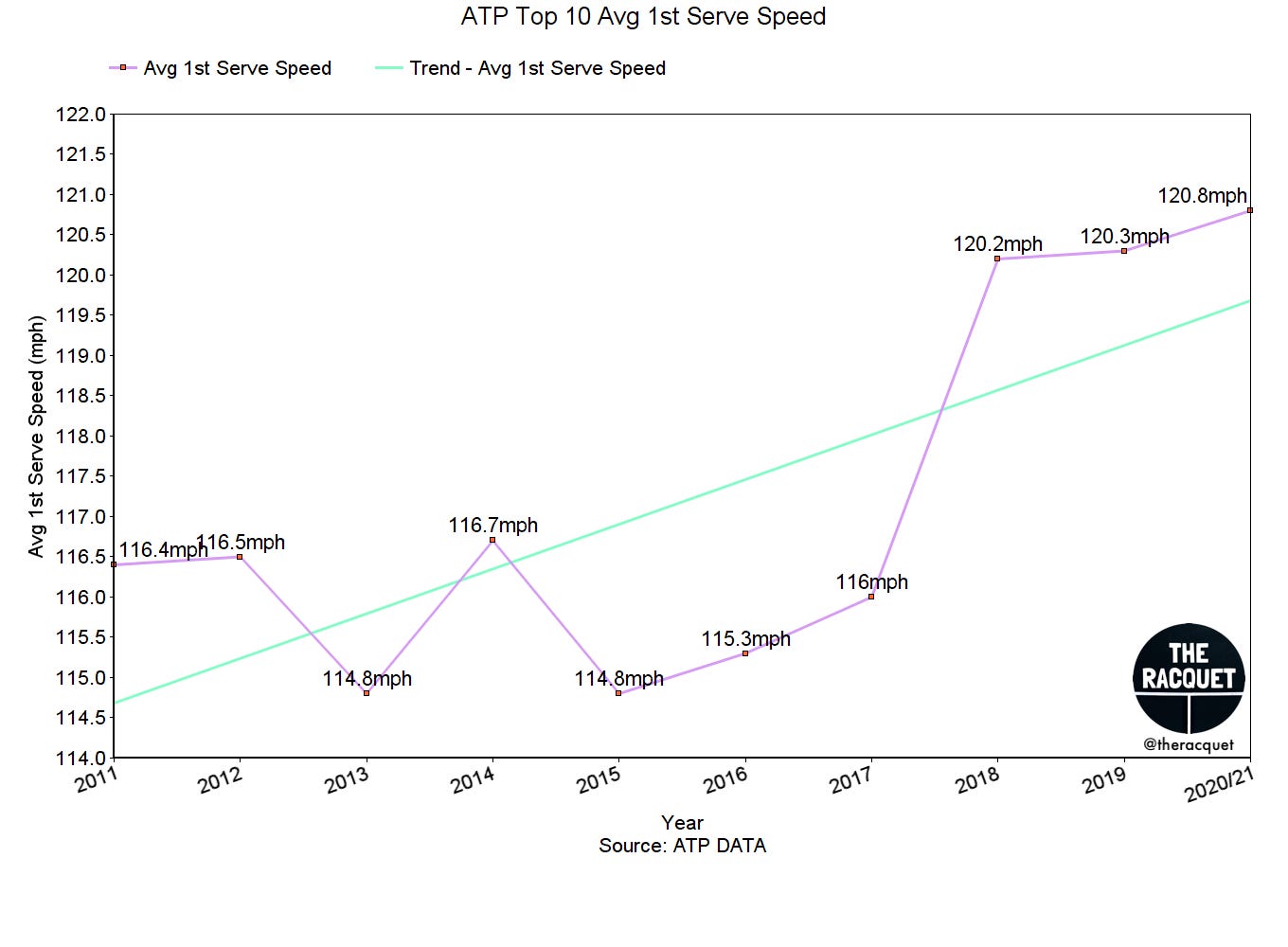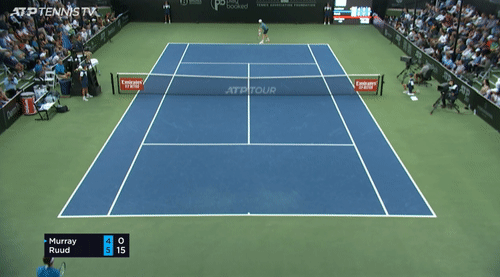Andy Murray lost to Casper Ruud yesterday in San Diego. While there’s certainly no shame in that loss, Ruud is No.10 in the world and having his career-best season after all, Murray has high standards, understandably, and probably thinks he should be more competitive in these matches.
Murray’s comeback from hip resurfacing has been very interesting for a few reasons. Firstly because Andy is pioneering hip-resurfaced athleticism considering no one has tried to play elite singles tennis, let alone win ATP titles, after such a surgery before. And secondly because he’s trying to work out ways to become competitive and win against the very best once again, after what was essentially a multi-year hiatus from the tour (Murray played in 2017 and 2018 but was compromised throughout and had his most recent hip surgery in January 2019).
Murray’s serve has never really been what made him great. For Murray’s years in the Top 10 from 2011 to 2016, he consistently ranked in the bottom 3-4 (out of the Top 10) in terms of elite serve performance, especially when it came to his rather attackable 2nd serve. In 2011 for example, Murray was the only player in the Top 10 who finished his season losing more 2nd serve points than he won (and that Top 10 featured David Ferrer who was hardly known for his big serve!). But there’s something really interesting about the timing of which Murray temporarily dropped off the treadmill that is pro tennis after 2016. As I wrote about recently, the last decade has shifted towards a norm of taller and bigger servers, with a lot of that change coming in the last four to five years:
As you can see, just as Murray leaves the sport due to injury, the game shifts slightly towards bigger serving (and more aces) albeit with a relatively constant hold of serve rate at the elite level. The older players, who had been in the top 10 since 2011 but were still around in 2017 onwards — ie Nadal and Djokovic — beefed up their own serves to keep pace (Nadal and Djokovic averaged 89 and 92mph respectively on their 2nd serves in 2011 but were both in the high 90’s and occasionally 100mph+ in 2019, 2020 and 2021).
Murray on the other hand has sort of stood still, perhaps understandably. And it might just be costing him.
Murray has played 25 matches in 2021. His serve performance so far:
1st serve won avg: 73%
2nd serve won avg: 49%
1st serve speed avg: 116mph (186kph)
2nd serve speed avg: 90mph (145kph)
When Murray left the tour, after his banner 2016 season, these were his serving stats for that year:
1st serve won avg: 76%
2nd serve won avg: 54%
1st serve speed avg (2016): 116mph
2nd serve speed avg (2016): 90mph
Life is like going the wrong way on an airport travelator.
Walk and you stay put.
Stand still and you go backwards.
The old saying above is probably applicable here, although the travelator that is pro tennis tends to move at an even faster rate than life in general. Murray’s serve doesn’t seem to have moved with the times since his hip surgery. And the manifestation is that he’s regularly being hurt in matches, even against non-elite opposition.
Just looking at a few of his recent losses:
Macro numbers aside there are two main micro issues for Murray’s serve effectiveness that popped up again and again in his loss to Ruud yesterday (and that have been recurring themes this year):
1st Serve +1 Forehand Potency





2nd Serve conservatism, speed and placement




The conservative 2nd serves were less of an issue for Murray in his Prime because that version of Murray could run all day and night, out-muscling just about any opponent physically in baseline exchanges. This just isn’t true any more. If Andy were in the Top 10 right now, he would have the joint-lowest 2nd serve speed of all ten players (only Rublev who has his own 2nd serve issues is in the same ballpark, although Rublev hits a bigger 1st serve).
Moving forward
There are issues other than Murray’s serve. Mentally it’s clearly an enormously difficult task to try to come back to the game in which he once was the best in the world. There have been matches, notably against Tsitsipas in New York and against Hurkacz in Metz, where Murray’s overall level was certainly not the problem. He played excellently for much of those matches, against elite opposition no less. But in both contests Murray simply didn’t play the big points well enough relative to his opponents. Murray has also made some more general adjustments in the last year or so to try and recapture his competitiveness. For example, he’s putting his excellent volleying skills to good use frequently, trying to shorten those points, as you can see in the clips above. But if his coaching team and he are willing, the more pressing and foundational experiment could well be to first try and optimise that serve (and forehand +1 although this is a more difficult task). Murray may well find that those volleys are suddenly easier on the back of more aggressive foundations. Even just 1-2% more routine service games for Murray would represent many more opportunities where he can do what he does best, i.e digging in and making a nuisance of himself on return of serve, perhaps with less pressure if he’s holding serve just a tad more easily.
There’s a wider topic about how not enough players on the tour optimise their serves, i.e how much faster and more aggressive with placement a player can get without committing a net-negative tradeoff in terms of the number of double faults. The elite players in men’s tennis seem to have done some of that optimisation in the last 4-5 years while Murray was gone from the top of the game.
At 6ft 3 it’s hard to believe there’s not a little more to squeeze out of that Murray serve. While significantly easier said than done, the former world No.1 will probably need it if he’s ever going to catch up.
Bonus:
Del Potro (at the US Open this year when asked about how he’s seen the competition change in the last few years since he’s been injured): “All the players are playing a very aggressive game now, with serves and forehands and very short points. From my point of view, a guy who makes a smart game, a smart play, he has the chance to win a tournament. That's the reason, I think, that Novak is still playing. He has the experience, he has the game, and he's very smart on court. The other guys are very strong, but that's a little bit of a message to me that, if I'm healthy, I can be in that position again.”
This quote was fascinating for a bunch of reasons but it also subtly endorsed the notion that the game has changed to bigger serves and more early point aggression in recent years. The assumed subtext was that Delpo believes a smarter player, with a bit more patience like Novak or himself, can exploit the ‘wham bam’ style of some of the younger players at the top of the game. Murray may have been somewhat left behind when it comes to some of the subtle changes over the last few years, but I’d guess that he’s certainly smart enough to capitalise if he can play catch up in some of the areas above.
— MW
I’ll see paid subscribers on Sunday.
The Racquet goes out twice a week, a (free) piece every Thursday and a (paid) analysis piece every Sunday/Monday. You can subscribe here:
Twitter @MattRacquet
Top & bottom: John Berry/Getty
// Looking for more?
Most recent:










Highly interesting and enjoyable piece, Matthew. Muchas gracias
Wooow. Another great piece Matt.
My english is not good enough to tell u how much I enjoyed this reading.
Love from Brazil! Take care.